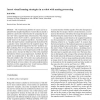Free Online Productivity Tools
i2Speak
i2Symbol
i2OCR
iTex2Img
iWeb2Print
iWeb2Shot
i2Type
iPdf2Split
iPdf2Merge
i2Bopomofo
i2Arabic
i2Style
i2Image
i2PDF
iLatex2Rtf
Sci2ools
BC
2000
2000
Insect visual homing strategies in a robot with analog processing
Abstract The visual homing abilities of insects can be explained by the snapshot hypothesis. It asserts that an animal is guided to a previously visited location by comparing the current view with a snapshot taken at that location. The average landmark vector (ALV) model is a parsimonious navigation model based on the snapshot hypothesis. According to this model, the target location is unambiguously characterized by a signature vector extracted from the snapshot image. This paper provides threefold support for the ALV model by synthetic modeling. First, it was shown that a mobile robot using the ALV model returns to the target location with only small position errors. Second, the behavior of the robot resembled the behavior of bees in some experiments. And third, the ALV model was implemented on the robot in analog hardware. This adds validity to the ALV model, since analog electronic circuits share a number of information processing principles with biological nervous systems; the anal...
ALV Model | BC 2000 | Model | Snapshot Hypothesis |
| Added | 17 Dec 2010 |
| Updated | 17 Dec 2010 |
| Type | Journal |
| Year | 2000 |
| Where | BC |
| Authors | Ralf Möller |
Comments (0)

